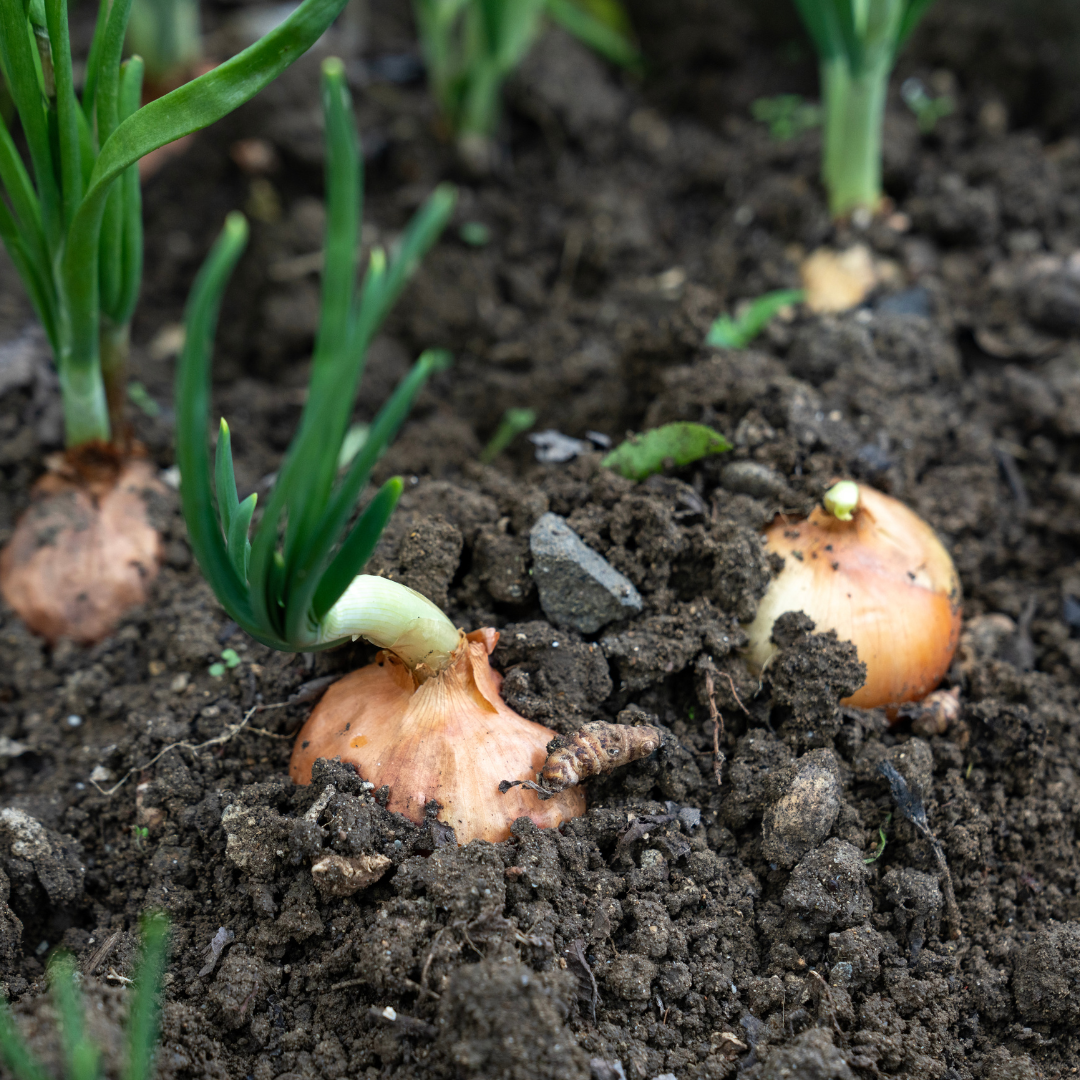Introduction
Growing onions is both rewarding and simple when you understand their needs. Onions are heavy feeders and require nutrient-rich, well-drained soil to develop large, flavorful bulbs. Choosing the best fertilizer for onions and applying it correctly throughout the growing season can make the difference between small, underdeveloped bulbs and a plentiful harvest.
Whether you’re starting with onion seeds, transplants, or sets, healthy soil and proper feeding are key. This guide covers how to choose the right onion fertilizer, when to apply it, and how to keep your onion plants thriving from early spring to harvest.

Choosing the Right Onion Variety and Soil Preparation
Different onion types grow best in different regions, depending on hours of daylight.
- Short day onions thrive in southern regions with 10–12 hours of daylight.
- Intermediate day and long day varieties need 12–16 hours and do best in northern climates.
To find the best match for your region, read our guide How to Select the Best Onions and Leeks.
Before planting, perform soil testing to determine nutrient needs and pH. Onions prefer slightly acidic soil (pH 6.0–6.8) that drains well. Enrich the soil with organic compost such as organic compost options and aged manure to improve fertility and texture.
Mix in organic fertilizers like blood meal for nitrogen and bone meal for phosphorus to strengthen root development before you plant onions.

The Best Fertilizer for Onions
Onions need steady nutrition throughout the growing season. The best fertilizer for onions is one that supplies a balance of nitrogen, phosphorus, and potassium. Nitrogen is especially important for promoting strong, green leaf growth, which directly supports bulb formation.
Popular options include ammonium sulfate, a fast-acting nitrogen source ideal for onion plants, or balanced fertilizers such as 10-10-10 for overall nutrient support. You can also use organic nitrogen fertilizer or high phosphorus fertilizer depending on soil test results.
How to Apply Onion Fertilizer
- Before Planting: Work in compost, bone meal, or blood meal about 2–3 weeks before planting time.
- During Growth: Side-dress with ammonium sulfate or other nitrogen-rich organic fertilizers every 3–4 weeks until bulbs begin to form.
- After Bulb Formation: Stop adding nitrogen when onions start bulbing—too much nitrogen at this stage delays bulb development.
Use soaker hoses for sale or drip irrigation to apply about 1 inch of water per week, keeping foliage dry to reduce fungal diseases.

Planting and Growing Onions Successfully
Plant onions in early spring when soil is workable. Onion sets or transplants should be spaced 4–6 inches apart in rows 12–18 inches apart. For guidance on planting, see How to Plant Onions – A Growing Guide.
Mulch lightly to conserve moisture and suppress weeds. Because onions have shallow roots, keep the soil consistently moist but never waterlogged. Use organic fertilizer or compost tea during the season to keep nutrients available.
If pests appear, such as onion maggots or thrips, try Pest Wizard Onion & Garlic Maggot Lure and read Common Pests: Controlling Onion and Garlic Maggots.
Harvesting and Storage Tips
Onions are ready to harvest when their tops turn brown and fall over. Loosen bulbs gently and let them cure in a dry, well-ventilated area for 10–14 days until the outer skins are papery. Learn more in Onion Harvesting and Storage Tips.
Once cured, store onions in a cool, dry, ventilated area. Hanging them in a mesh bag allows airflow and prevents rot. Pungent varieties keep longer than sweet ones—some can last for months under proper conditions.

Managing Onion Problems Naturally
Yellowing leaves, stunted growth, or bulb rot often result from poor drainage or nutrient imbalance. Regular soil testing, using balanced fertilizers, and rotating crops help prevent these issues. For more guidance, read Solving Common Onion Growing Challenges.
Avoid planting onions in the same bed as garlic or leeks for at least two years to reduce disease buildup. Crop rotation and pest barriers from our collection of barriers can protect your onion plants naturally.
Conclusion
Choosing the best fertilizer for onions ensures healthy growth and abundant harvests. Combine nutrient-rich soil, balanced fertilizers, and consistent moisture to help your onion plants thrive. Whether you grow short day onions or long day types, follow proper feeding and watering practices to enjoy crisp, flavorful bulbs all year long.
For seeds, sets, and supplies, explore our full range of onion seeds, onion sets, and fertilizer and growing supplies.


3 comments
Vicky, well sounds like you are doing what you need to for the onions. They grow super slow from seed, so I would say just have lots of patience for the onions. After they get bigger, maybe switch to an all purpose liquid and give them a diluted solution.
How to care for onions grown from seed? I have 2 shelves full (6 trays 11 X20) and am using grow lights, also weak fish emulsion. What else will help these seedlings until they can go outside (end of April here in Z4).
Looks great! this is nice and this article is very helpful
thanks for sharing